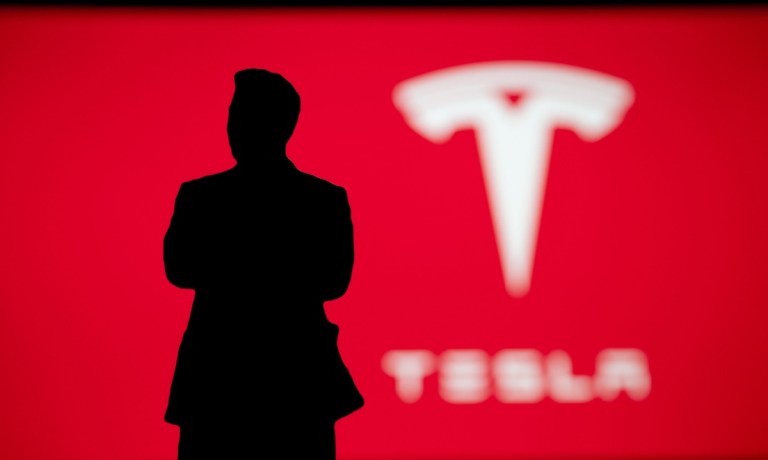
What has four wheels, two seats, no steering wheel and arrived a few years late?
Tesla’s long-awaited robotaxi, which CEO Elon Musk had predicted in 2019 would be launched by 2020.
But it wasn’t until this Thursday evening (Oct. 10), in the year 2024, that Musk finally unveiled his plan for the future of autonomy, traversing the fake streets of the Warner Brothers studio in California in order to debut Tesla’s “Cybercab” prototype.
And the Hollywood setting matched the Hollywood-style hyperbole of the event, which was light on details and launch timelines while heavy on promises that included self-driving cars, cybervans and cybercabs, as well as fully autonomous bipedal “Optimus” robots.
“The future will look like the future,” said Musk, adding, “autonomy will create the world we want.”
Among the concrete details shared at Thursday’s “We, Robot” event was a promise that Tesla would start building the fully autonomous Cybercab by 2026 or 2027, and sell it for a price of less than $30,000, as well as the debut of a sister-vehicle robovan capable of transporting up to 20 people.
Musk’s vision for these autonomous vehicles is not just about individual ownership but about creating a network of self-driving taxis that are accessible and affordable for the general public. The initiative is seen as a direct challenge to traditional ride-sharing services, with the potential to drastically reduce the cost of transportation.
Still, it was Tesla’s stock price that sank after the flashy event, while both Uber and Lyft shares were up low single digits as of reporting.
Read more: Can Robotaxis Accelerate the Future of Automated Driving?
Tesla’s current market cap is the size of many other leading carmakers — combined — and the electric vehicle (EV) maker’s valuation has long been inflated by, or rested on, Musk’s many promises to solve autonomy by releasing revolutionary products and services.
Yet despite Musk’s track record of defying the odds, his decision to move Tesla away from its core business of making and selling EVs toward one geared toward robotics and artificial intelligence (AI) is spooking investors more focused on the realities of the company’s near-term product roadmap.
And the road to realizing Musk’s vision is fraught with challenges, not least of which is the regulatory hurdle. Autonomous vehicles, especially those intended for public transport services, face stringent scrutiny from safety regulators. As PYMNTS previously reported, the U.S. Department of Justice (DOJ) is investigating Tesla’s Autopilot and Full Self-Driving (FSD) systems following crashes that continued to occur despite a December recall of over 2 million vehicles.
Tesla is also lagging behind other autonomy players. This past August, Google-owned Waymo began offering 24/7 robotaxi service at the Phoenix Sky Harbor International Airport, while automaker Mercedes has beaten Tesla in the domestic autonomy race and become the first automaker to sell Level 3-rated autonomous vehicle systems on United States soil.
It comes at a time when a PYMNTS Intelligence report, “How Generative AI Is Boosting Innovation for Carmakers and Drivers,” finds that 3 in 4 (75%) of automakers plan to integrate generative AI technology into their operations.
Anna Brunelle, CFO at May Mobility, told PYMNTS in February, “I believe in our lifetime, not just automobiles, but every piece of moving machinery on the face of the earth will be automated. And the smart infrastructure that oversees it and supports it will also be automated.”
Still, as one of the co-founders of the autonomous vehicle company Cruise said, there are over a dozen key things to keep an eye out for as autonomy progresses — including such conceptually mundane elements as bad weather, yielding to emergency vehicles, and even sensing things like potholes and flooded roads.
Read more: From Factories to the Fast Lane, Unpacking Autonomy’s Potential
Autonomy is just one piece in the connected economy of the future. And that future will be built around and supported by better payment methods that enable commerce across this emerging landscape.
“It’s a new market. We do not have transactions right now inside cars. None of us are familiar with what it would even mean. Therefore, when we talk about launching a new category like in-vehicle payments, we have to make it as convenient as our existing payment methods,” Evgeny Klochikhin, founder and CEO at Sheeva.AI, told PYMNTS for the “AI Effect” series.
PYMNTS covered earlier that payments in robotaxis aren’t just about the ride itself. The data generated by these vehicles — such as user preferences, travel patterns, and in-vehicle purchases — can be monetized. Companies might develop new revenue streams by selling anonymized data to third parties or using it to offer targeted services and advertising, all of which require a robust payment infrastructure.
And one of the more interesting, if yet-to-be-realized, debuts during Tesla’s event was the unveiling of the Optimus humanoid robot. Purpose-built robots could transform traditional warehouse operations.
“Where we’ve had success is on the services side of robotics, in the logistics and warehouse space where [the robots] can do repetitive tasks like a human,” Austin Noronha, managing director U.S. at Sony Ventures, told PYMNTS in an earlier conversation.
Of course, these robots will need their own payment systems — an advance that could streamline operations and unlock new efficiencies. By embedding digital payment systems directly into these robots, warehouses could automate purchasing decisions based on real-time inventory data. This just-in-time approach could dramatically improve efficiency while reducing human error or payment bottlenecks.